


A record number of members (104) attended the seventh annual TCC meeting in Philadelphia. Peggy and Fred Sutor organized the successful, activity-filled event. They were thanked many times during the course of the meeting for their efforts.
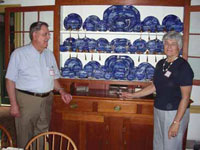 |
Ruth & Fred Buch with part of their collection of the Landing of Lafayette |
Thursday, October 19, Optional Day Activities, reported by Jane Diemer:
I had a Christmas morning experience of wonder, surprise and delight when I visited the Pennsylvania homes of Ruth and Fred Buch and Terry and Bill Kurau - four inveterate, talented collectors of transferware. It was like Winterthur in miniature - fine furniture and other antiques delightfully displayed and, of course, THE DISHES. At the Buch home we saw collections of “Landing of Lafayette”, “Lafayette at Franklin’s Tomb”, “The Sower” in red and an extremely rare red Staffordshire flask. Then in their den were mixtures of other early British ceramics, among them clobbered pieces of ironstone and Adams and a wonderfully printed greenish black cup and saucer (unknown pattern to me) I would have given my eye teeth for. The color was striking.
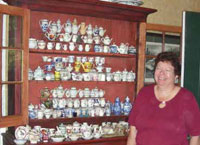 |
Terry Kurau and her miniature teapot collection
|
|
Terry Kurau’s hutch filled with miniature beverage pots in many patterns sparked many lustful oohs and aahs, and the immense blue and white transferware pitcher (pictured here with Jane Diemer) was so big my youngest grandchild would have fit inside. That was the Kurau item I would have adored having. There were many incredible rarities at the Kuraus’ home, and any novice collector would have loved having these hosts create a workshop in patterns right then and there.
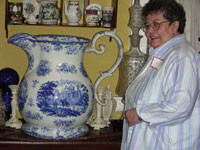 |
Jane Diemer with her coveted jug at the home of Terry and Bill Kurau |
|
We thanked these hospitable TCC members for graciously allowing us to view their really beautiful collections, and great thanks indeed to Terry Kurau and her family for entertaining with a delicious under tent luncheon, creating a fine chance for meeting people and chatting about our own collections.
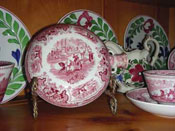 |
Rare Palestine Flask from the Buch Collection |
Following late afternoon registration, social hour, and dinner, Peggy Sutor gave a presentation on Philadelphia, the Little Athens of the Federal Period which set the tone for the Philadelphia-related activities of the meeting. Peggy focused on15 Philadelphia views featuring neoclassical architecture. During the Colonial Period in Philadelphia, buildings were built of wood and brick by master builders. The influence of Great Britain’s neoclassical style of architecture and the availability of marble gave rise to the Federal Period (1800-1825) in Philadelphia. This period was characterized by marble structures constructed by men self-educated in the style and craft.
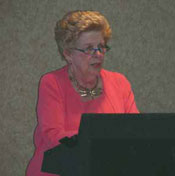 |
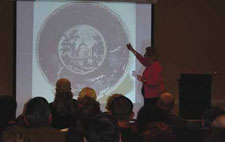 |
Meeting Chair Peggy Sutor during her presentation "Philadelphia, the Little Athens of the Federal Period" |
For each of the 15 views, Peggy gave the potter, series, form, source print, provenance and comments. Some of the details of 4 of the views follows. First Waterworks of Philadelphia: 10” plate by Stevenson; beaded bowl by Jackson; completed 1801 in Centre Square. Second Waterworks of Philadelphia: seven potters committed this structure to their china (Stubbs, Henshall and Williamson, E. Wood, Ridgway, T. Godwin, C. Meigh, and Jackson) in various forms (soup tureen, platter, beaded bowl, plate, tureen, pitcher); completed 1824 at Fairmont. Pennsylvania Hospital: 11” potato bowl; Ridgway’s Beauties of America series; right wing completed in 1755, left wing in 1796, and center building in 1805. Masonic Hall: 8” plate; Ridgway’s Beauties of America series; first building dedicated in 1811, burned to ground in 1819, and built on same site in 1820.
The remaining views mentioned were Philadelphia, First Bank of U.S., Customs House, U.S. Hotel, Library of Philadelphia, Staughton’s Church, Deaf and Dumb Asylum, Upper Ferry Bridge, Mendenhall Ferry, Woodlands, and A View Near Philadelphia.
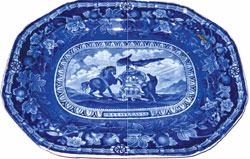 |
21" Arms of Pennsylvania Platter from the Arms of the States series by T. Mayer, c. 1830. This magnificent transferware platter is part of the Philadelphia Museum of Art collection examined by TCC members. No vote was taken (or even suggested) but it undoubtedly would have been chosen the piece most members would have loved to take home with them if they could have selected one item from among the Museum's collection! |
Friday, October 20: Friday morning we boarded buses to the Philadelphia Museum of Art, Fairmount Water Works, and Freeman Auction house.
The Philadelphia Museum of Art was founded in 1876 and is housed in an impressive building in the neoclassical style. Upon arrival, we were divided into three groups and guided by knowledgeable museum staff to each of three collections related to transferware.
The first collection viewed was china made in America. American china manufactories sought to supplant British imports by providing the colonists with comparable domestic ware. One of these manufactories, and perhaps the first in this country, was started in Philadelphia by Gousse Bonnin, an American, and George Morris, an Britishman. The first firing of Bonnin and Morris soft paste porcelain was in 1770. The factory failed rapidly and was out of business by 1772 because the colonists continued to purchase better quality and less expensive British products. There are only 19 known pieces of Bonnin and Morris china and 88 boxes of archeological materials. The surviving pieces are a limited number of forms, but the archeological finds indicate significantly more forms and functional dinner sets. We were shown the small, blue and white, three footed pickle tray in the museum’s collection. The tray is the in the form of a shell modeled after a shellfish found in the Delaware River. Philadelphia’s second venture into porcelain manufacture was the Tucker Porcelain Manufactory founded by William Tucker in 1826. The manufactory produced a variety of wares, including tea and dinner services, but it is best known for its production of elegant amphora vases and pitchers in the classical Greek style. The museum has 545 pieces of Tucker porcelain. We were shown several of the vases in the Greek style and painting. The elements of and details on Tucker porcelain are not crisp and clear, proven true by observation, and would have been “trashed” in Europe according to the guide. However, the manufactory was successful and remained in operation for 12 years.
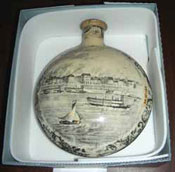 |
American Historical Flask (Pittsburgh w/ Steamboats Home, Lark & Nile) from the collection of the Philadelphia Museum |
Next we viewed the collection of Pennsylvania German earthenware from 1780 - 1840. Immigrant farmers made the wares after hours in their own potteries as many of them had done in Europe. Pennsylvania is the only region where the sgraffito technique was used on the redware. The sgraffito process involves scratching designs on pieces coated with a layer of slip, a liquid clay mixture, resulting in more elaborately decorated pieces.
Finally, we were taken to the museum’s storage area to view the museum’s transferware collection (450 pieces). Half of the collection was given by a single donor. In addition to the pieces in the storage cupboards, a table was set up displaying many of the American Views Peggy had shown during her presentation the night before. The three most exciting pieces were 1) the very large platter from Mayer’s Arms of the States series showing the Arms of Pennsylvania; 2) a two handled tankard by Henshall, Williamson and Co. showing the Dam and Water Works, Philadelphia; and 3) a beautiful black and white canteen by Clews showing the Hudson River View.
 |
TCC Members exploring the ceramics storage area at the Philadelphia Museum |
Following the museum tour, we were on our own for several hours to explore the other collections of the museum or to take the short walk down the hill to the Fairmount Water Works. One could spend hours in the museum’s collections of nearly 225,000 works of art. There are extensive collections of European art from three different periods. The Asian collection was most interesting in that it contained several entire rooms and/or structures reconstructed in the museum, including an Indian temple, Chinese reception hall, and Japanese teahouse. The Fairmount Water Works complex on the Schuylkill River is as impressive in actuality as it is in the source prints and on the transferware pieces. It has not pumped water since 1909 and now houses educational exhibits and a theatre.
Late afternoon we arrived at Freeman’s Auction House, the oldest auction house in America. The owner, Beau Freeman, who has many years of experience, spoke about selling collections through the auction process. The job of the auctioneer is to work with the executor or beneficiary to set the terms of the sale of the collection. A rough estimate of the auction value of the collection, commission, and terms of the sale are determined and agreed upon. The collection is then shipped to the auction house and inventoried. Finally, the auction house advertises the auction, exhibits the pieces for 3-4 days, holds the sale, and pays the seller.
A question and answer period followed the short presentation. Beau advised that one way a seller can optimize the income obtained for a collection is to have more than one sale, with the time between sales at least two years. The auctioneer needs between 150-200 pieces in a lot of goods. Generally, because only the “good” items will sell, the auctioneer may sell the remaining items to another auction house or the remaining items can be reoffered at a lower reserve. If the lots have fewer pieces, but the pieces are valuable, the best route is to put the pieces in another auction with more items.
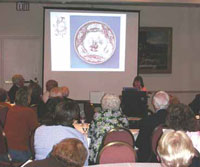 |
Margie Williams discussing Historic English Pink |
The day’s activities concluded with a presentation by Margie Williams on Historic English Pink made especially for the American market. Her knowledge of the pieces and potters of pink and white was evident during her presentation of American scenes by seven potters and their source prints when available. Some of the pieces relevant to the focus of the meeting are as follows. W. Penn’s Treaty View #6 by Thomas Godwin. Dumb Asylum from the Four Medallion series by Enoch Wood & Sons from a source print by Charles Burton. Penitentiary at Allegheny, Pa. from Picturesque Views by James and Ralph Clews. Catskill Mountain House from the American Views by William Adams & Sons from a source print by Thomas Cole.
Margie has also added a third book to those she has written on pink and white transferware. The book entitled American Historic English Pink, American Views on English Transferware was released in October and published by Margie’s company, Altarfire Publishing. Contact Margie at margie@altarfire.com to order her book.
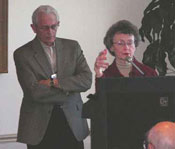 |
TCC President Loren Zeller and Database General Editor Connie Rogers |
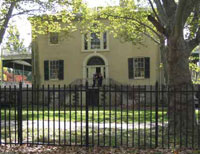 |
Lemon Hill as seen today and on the Stubbs Platter "Fair Mount Near Philadelphia" |
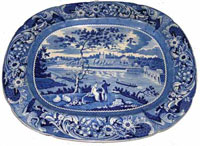 |
Saturday, October 21: Saturday was another activity filled day beginning with the TCC Annual Meeting moderated by our President, Loren Zeller.
The Treasurer, Chet Creutzburg, reported that the club continues to be financially successful with a positive balance every year. From 04/10/06 through 10/17/06, the TCC had total cash receipts of $60,943.59 and cash disbursements of 13,025.74 for an increase of $47,908.85.
Membership chair, Judie Siddall, reported that the TCC currently has 257 paid members out of 303 total, up from 170 paid members and 205 total last year. There were 76 new members between 10/2005 and 06/2006. Sixty of these members paid using PayPal, indicating the recruiting ability of the website. She also stated that the membership dues will be raised to $40 for U.S. members and $50 for non- U.S. members. The increase is needed to cover the database development and other benefits.
Web Site Administrator, David Hoexter, reported on the status of the web site. (Ed. Note: David and Judie Siddall’s separate report about the Web Site can be found in this issue.)
President and Database Manager, Loren Zeller, and Database Editor, Connie Rogers, reported on the status of the pattern database. (Ed. Note: Connie Roger’s separate report about the Database can be found in this issue.)
Membership chair, Michael Sack, called for nominations from the floor. The officers unanimously elected are: Loren Zeller, president; Margaret Sutor, vice president; Chet Creutzburg, treasurer; and Jackie Overman, secretary.
The Board reported the venue for the next three meetings as follows: Hartford, CT in 2007; Williamsburg, VA in 2008; and Bath, England in 2009 (TCC’s 10th anniversary). The meeting was adjourned.
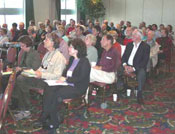 |
TCC Members in formal session |
Following the meeting, we boarded buses to Lemon Hill. On the way, the still extant sites of the 15 sites Peggy showed during her presentation were pointed out, including Customs House, First Bank of U.S., Library, Deaf and Dumb Asylum, Philadelphia Hospital, and the Woodlands. Lemon Hill is one of seven historic villas located in the 90,000 acre Fairmount Park along the Schuylkill River. Henry Pratt, a Philadelphia merchant, built Lemon Hill in 1800 on property formerly owned by merchant and financier Robert Morris. It is designed in the neoclassical style and features three oval rooms with curved doorways and fire places. The Lemon Hill transferware collection contained a good representation of Peggy’s 15 sites. The most exciting were the Fairmount tureen and under tray on display on the first floor. The embossed eagle decoration on the lid is wonderful when one notices that the eagles are presented in two ways: on one side the eagle is clutching the olive branches of peace; on the other side the eagle is clutching the arrows of war. The second exciting piece housed in the second floor cabinet was the small, rare pickle dish with Upper Ferry Bridge on it.
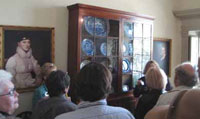 |
Staffordshire from the collection at Lemon Hill |
After several free hours for lunch, sightseeing, or resting, we reconvened for an educational lecture on Staffordshire Exports to America, 1806-1830 by Roger Pomfret. Roger’s lecture was based on his commissioned study of a manuscript of the letters of Matthew Smith. In 1804, Smith worked as a merchant dealer for the Staffordshire potteries. In order to be closer to the U.S. market, he sailed to Baltimore in 1806 and opened a business selling transferware through a British agent who worked with the potteries. From that time until he retired in 1832, Smith wrote letters, similar to a diary, of his business dealings, resulting in a 900-page manuscript. The lecture focused on four major topics that emerged from the letters.
Problems with the passage of goods. The problem of receiving orders in good condition was a continual concern for Smith. Several factors affected the arrival of pottery in good condition. The 3100-mile journey from the potteries to Baltimore was hazardous on a good day, let alone when complicated by windy seas and icy harbors. How the pottery was packed in the crates and the handling of the crates greatly affected its arrival condition. In addition, the crates had to be repacked for inland travel and had to be of a size to fit in the wagons.
Peculiarities of the American Market. Americans showed a continuing demand for octagon shape wares as indicated by an 1811 order for 11 crates of these wares. There was an early popularity of underglaze brown wares in U.S. Smith had orders for brown wares from 1810 until 1816. Smith’s records also show that green edgeware, which was inexpensive to make and manufactured exclusively for export, was very popular in the American market. Today these are rare pieces, but they can be seen in Winterthur’s large collection. Smith’s orders also show the progression of the popularity of dark and light blue ware in the American market. From 1817 to the early 1820s the orders were for dark blue. In late 1826, orders for light blue began to appear. In 1828, city folk wanted light blue, but country folk still wanted dark blue. By 1830, the orders were predominantly for light blue.
Finance and Competition. Discounts, credits, allowance for breakage, larger wares were some of the issues Smith had to deal with to keep his business viable. Early in his business from 1806-1812, Smith worked closely with his British agent, a Mr. Wyld, who knew what he wanted and the potteries that could provide it. There were times Mr. Wyld overlooked his not being able to pay for orders, allowing him to keep two years of inventory in stock. These were prosperous years. However, the 1820’s saw increased competition. The larger Staffordshire potteries employed traveling representatives and dedicated agents in the U.S. allowing them to provide larger discounts.
The Firms Smith Worked with. Initially, Smith specified the manufacturer of the pottery on an order and his letters contain editorial comments about some of them. He worked with 40 firms over the years of his business. He spoke highly of Ridgway, but did not purchase much from them. He worked extensively with John and Richard Riley, from whom he purchased blue wares, because of the quality of their product and the special terms he could set up with them.
In closing Roger voiced his opinion based on his study of the letters that Matthew Smith was a shrewd, self-righteous, and humorless individual who provided a mine of information about the American export market.
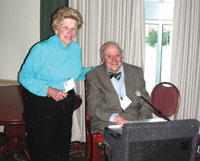 |
Peggy Sutor and speaker Bob Teitelman |
Later that day, attorney and author Bob Teitelman provided a visually rich presentation on Liverpool Pottery. From 1796 to 1806, more pottery was produced in the Herculaneum pottery in Liverpool than in the Staffordshire potteries. The most common form of Liverpool pottery is the jug in the globular or ballister shapes and the most common decoration is transfer print. Bob’s presentation was divided into six design categories: people; events; patriotism; trade and industry; slavery; and places.
Unfortunately, he was only able to show his representative pieces for the first three categories due to the number of pieces he has in each category, the interest showed by the audience, and time limitations. Some of the people designs were of Ben Franklin, George Washington, and Thomas Jefferson. The events category included scenes of the military, navy, militia, first census, and the death of Washington. Finally, scenes in the patriotism category included emblems of the eagle and the states New York, Virginia, and Massachusetts; and allegorical figures of the America as the Goddess of Liberty. The day ended with a colonial style dinner at Philadelphia’s historic City Tavern.
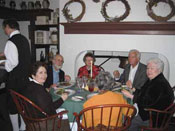 |
|
|
Saturday evening dinner at Philadelphia's historic City Tavern |
Sunday, October 22: If you want to know anything or everything about the Richard Jordan pattern, ask Randy Boyer or his father, Dan. They have researched the preacher, pattern, and source print and Randy gave a presentation of their findings. Richard Jordan was born in Virginia in 1756. Initially he was a farmer who became a Quaker minister in 1787. The pattern name is The Residence of the late Richard Jordan New Jersey, potted by Joseph Heath & Co. The source print is taken from an 1825 drawing by William Mason, a friend of Jordan’s.
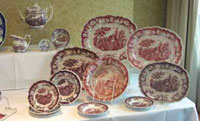 |
Collection of Richard Jordan transferwares offered at the Show & Sale by Peggy Sutor |
The intriguing aspects of this pattern include its forms, colors, and oddities, and why the source print become an American historical pattern. The pattern has been found in complete dinner sets in a rainbow of colors, a variety of forms, and some forms in a variety of sizes. Randy and Dan had heard of a green piece of the Richard Jordan pattern and traveled to Detroit to verify the 9 1/4” plate existed. Subtle variations in the transferred pattern were also pointed out. For example, the house on one side of a pitcher has two chimneys, but the house on other side has three. The question as to why the drawing became a source print has not been answered. Randy conjectures that the drawing and pattern may have been ordered by friends of Jordan as a commemorative or it was a commercial opportunity for Heath to pick an appealing subject for a new china pattern. The pros and cons of each conjecture were presented, with no conclusions reached.
Randy has compiled a census of the Richard Jordan pattern documenting the permutations of form, color, and size of the pieces. He asked members to add to his census by completing the form for their collections. If you are able to assist his endeavor, email Randy at randybo@comcast.net.
Royce Walters gave the final presentation of the meeting titled In the Footsteps of Lewis and Clark: Transferware Invades the West. In June, 2005, when Royce visited Fort Atkinson on the Missouri River at Council Bluffs, Nebraska, he learned that over 1000 ceramic shards had been found at the site. Consequently, the site offers insight into the spread of transferware in the U.S., the rising standard of living in the U.S., and the increase in the size of the market for domestic goods.
Fort Atkinson was occupied from 1820-1827. Since then it has been disturbed little and provides a pristine site to explore the nature and extent of British ceramics in the U.S. During its occupancy, 1100 military personnel and their dependents lived at the site. The largest contingent came from Plattsburg, New York. The travel time from New York to Fort Atkinson was six months. Records indicate that during the journey West, the travelers brought all the domestic accoutrements with them; about 2500 pots transferred across the country. The transferware shards found at the site confirm this. There were approximately 900 documented plain shards, 1800 documented pearlware shards with transferware designs, and very little or no documented creamware shards. Blue transfer on pearlware was the largest body of ceramics on site. No historical scenes or portraits in creamware or blue and white were found. Spode Willow and Italian patterns were found, as well as patterns by Enoch Wood and Hamilton.
The route of the ceramics to Fort Atkinson could have been through Pittsburg or St. Louis. Pittsburg was the gateway to the West until the railroad was completed to Chicago. St. Louis was the logical route because of its location. It is probable that both of the sites were used. Records show that trade on Fort Atkinson was controlled by a John Kennerly, who had contacts in St. Louis and left a diary, but it did not specify sources of the ceramics. An 1821 inventory at the Fort showed over 1000 articles, but what kind or from where they came was not specified. That same year a St. Louis directory was first published showing no ceramic importers; in 1836, three ceramic importers were listed and in 1837 seven were listed, documenting the expansion in the distribution of ceramics to this area. With the migration of people to the West, trade followed the demand and continued the economic viability of the potteries in the 19th century.
|
|
 |
|
Sale Tables on Sunday afternoon |
The 2006 Annual Meeting ended with the much anticipated show and sale. Once again, we were not disappointed in the wonderful items the dealers beautifully displayed for viewing and buying.
Photos courtesy of Loren Zeller and Michael Weinberg.
Rich with content for ceramic collectors, researchers, authors, curators, and historic archaeologists, the sites are sure to deliver value for their visitors. The exhibition’s curators continue to enhance them and, now, with site application upgrades, including a new magnification feature and upgraded content management capabilities, the TCC and its collaborators are pleased to relaunch these exhibits, all free to a worldwide audience.
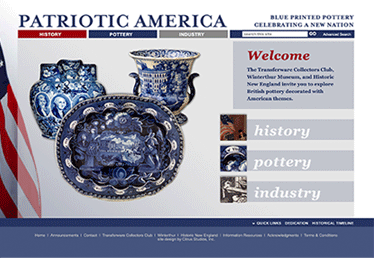
Branded Patriotic America, debuted in 2014 in collaboration with Historic New England, and the Winterthur Museum
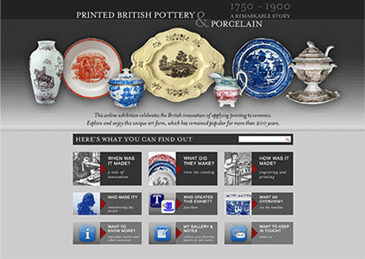
Launched in 2015 in partnership with the Northern Ceramic Society.
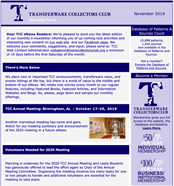 Not a member but want to receive email updates?
Not a member but want to receive email updates?